Update – Emma Hybrid Comfort has been discontinued and replaced by the Emma Performance. See our review here.
COUPON – Save 5% off your order with code NAPLAB.
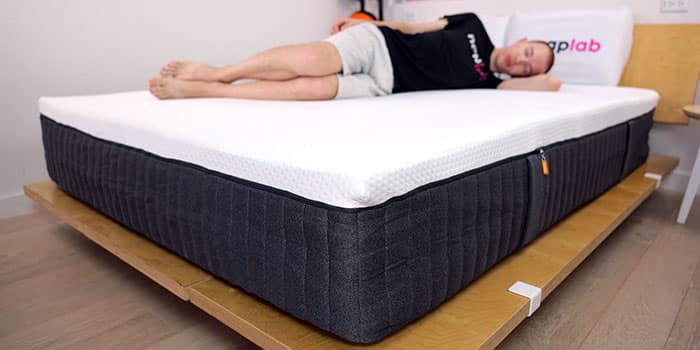
Best For
- Outstanding edge support
- Fast material response time
- Excellent cooling with limited heat retention
- 365-night trial with free returns if things don’t work out
Considerations
- Higher levels of motion transfer, may not be suitable for sensitive sleepers
- 60% thinner comfort layer than the average
Our Verdict
The Emma Hybrid Comfort is a 13″ thick mattress (however, the one we received was 12″) with well-rounded performance, comfort, and support. It uses a taller pocketed coil and a thinner comfort layer than average. But the overall result is a mattress with exceptional edges and fast material response time.
It has minimal sinkage and very high bounce giving the mattress a “floating on top” of the mattress feel.
It comes in a single firmness of 7 out of 10, where 10 is the most firm. This makes it a good option for back and stomach sleepers of all body weights, but side sleepers may be better served elsewhere.
The Emma Hybrid Comfort mattress has an overall score of 8.44 which placed it in the bottom 35% percentile compared all mattresses tested to date.
Emma is available in both the the US here and Canada here.
Type: Hybrid
Firmness: Slightly Firm (7)
Best For: Back or Stomach Sleepers, All Body Weights
In This Review
Performance Tests | Firmness | Support & Sleeping Positions | Design | Materials | Comparisons | FAQs
Performance Tests
At NapLab, we put each mattress to the test.
We test 10 different factors that impact the performance, comfort, and value of the mattress. We then take the results of that test and compare to every mattress we’ve tested to date.
Check out the full performance table below to see how this mattress ranks:
| Factor | Emma Hybrid Comfort | Average |
|---|---|---|
| Overall Score | 8.44 | 8.55 |
| Price (Queen) | $659 | $1,332 (Hybrid only) |
| Cooling – Score | 9.0 | 8.7 |
| Sinkage – Depth | 1.84″ | 2.14″ |
| Sinkage – Feel | Minimal | Moderate |
| Motion Transfer – Score | 7.5 | 8.2 |
| Motion Transfer – Acceleration | 10.51 m/s² | 8.78 m/s² |
| Response Time – Score | 8.9 | 8.9 |
| Response Time – Mostly Recovered | 0.3 sec. | 0.4 sec. |
| Response Time – Fully Recovered | 1.1 sec. | 0.9 sec. |
| Bounce – Height | 12.55″ | 9.54″ |
| Bounce – Feel | Very High | Moderate |
| Edge Support – Score | 9.5 | 8.6 |
| Edge Support – Sitting | 3.00″ | 4.03″ |
| Edge Support – Lying | Excellent | Good |
| Sex – Score | 9.7 | 8.5 |
| Pressure Relief – Score | 7.0 | 8.7 |
| Comfort Layer Thickness | 1.8″ | 4.1″ |
| Mattress Thickness | 12″ | 12.0″ |
| Off-Gassing – Score | 8.1 | 8.1 |
| Off-Gassing – Smell | Strong | Strong |
| Off-Gassing – Days | 7 days | 7 days |
| Company – Score | 9.0 | 8.8 |
| Trial | 100 nights | 178 nights |
| Warranty | 10 years | 25% have lifetime warranties, average of other 75% of mattresses is 13 years |
How is the Emma Hybrid Comfort Different?
The Emma Hybrid Comfort mattress has average performance and a significantly lower price tag—a savings of 56.2% compared to the average hybrid mattress we’ve tested to date.
Advantages
Looking at specific performance categories, the Emma has slightly better cooling than average as well as a slightly faster response time, better edge support, and better sex performance.
Neutral Factors
Concerning more preferential factors, this mattress has 14% less sinkage than average as well as 23% more bounce than average. These two factors are neither good nor bad, but rather an issue of preference.
Disadvantages
Strikes against the Emma Hybrid Comfort include higher levels of motion transfer and a comfort layer that is significantly thinner than average. On average, comfort layers are typically around 4.1″, but the Emma Hybrid Comfort only offers 1.8″.
This can be problematic for heavier sleepers or those who are prone to pressure relief issues.

Cooling Test
Cooling performance was excellent on the Emma Hybrid Comfort. During our tests, I felt no significant level of heat retention.
Baseline Temp.
84.3° F
Max Temp.
95.0° F
Ending Temp.
87.0° F
While the thin 1.75” comfort layer doesn’t do any favors for pressure relief, when it comes to cooling and avoiding heat, a thinner comfort layer is beneficial. In addition to the thin comfort layer we have a 7.75” coil unit that creates plenty of airflow.
Max Temp.

Ending Temp

- Baseline Temperature – the temperature of the mattress before anyone lies on it
- Maximum Temperature (0 minute) – the temperature of the mattress after lying on it for 15 minutes
- Ending Temperature (5 minute) – the temperature of the mattress after being lied upon and having no one on it for 5 minutes
In our objective cooling tests, we measured a max surface level temperature of 95.0°F. While the max temp baseline is notably higher than average, the minute-by-minute temperature reduction was solid.
From minutes 0 to 1 the temperature declined by 5.0° (0.28° cooler than average). From minutes 0 to 5 the temperature drop was 8.0° (0.4° cooler than average).
Heat Dissipation Over Time

Given the higher starting temp, these better-than-average heat retention measurements aren’t quite as impressive as they otherwise would be.
Nevertheless, I am pleased to see that the mattress doesn’t hold onto heat as aggressively. All that to say, the Emma Hybrid Comfort isn’t perfect when it comes to cooling, but given the price point, it’s not bad at all.
Sinkage Test
The Emma Hybrid Comfort has a minimal level of sinkage. In our pressure point sinkage tests we measured a sinkage depth of 1.84”. This is 0.30” less sinkage than the average of 2.14”.
Sinkage Depth
1.84″
Sinkage Feel
Minimal
Body Contour
Slight
The mattress has a slightly firm feel and a thin comfort layer (1.75” of foams). These factors combine together to greatly reduce the level of sinkage. The mattress creates an extremely restrained level of body contouring hug.
The level of sinkage is documented in the image below.

Sleepers will “float” more on top of the mattress, as opposed to sinking down “in” the mattress. This type of feel isn’t necessarily good or bad, but it is a specific feel.
You’ll want to really be sure that your body prefers the floating, slightly firm feel to be comfortable on the Emma Hybrid Comfort. This type of feel is generally better suited to the needs of back and stomach sleepers and is not a good choice for side sleepers.
Motion Transfer Test
The Emma Hybrid Comfort has a moderate level of motion transfer. In our tests, we measured an acceleration range of 10.51 m/s². This is 16.5% more motion than the average of 8.78 m/s².
Accel. Range
10.51 m/s²
Motion Duration
1.18 seconds
The level of motion transfer is also documented in the video below.
The slightly firm feel and limited foam comfort layer are creating a higher-than-average motion.
In our motion transfer chart, which visualizes our accelerometer data, we see the highest motion spikes from 0 to 0.21 seconds.
Motion Transfer Over Time

Motion does drop off thereafter, but it isn’t until 1.18 seconds that we return to near-zero levels. Mattresses with the lowest motion are able to return to near-zero energy levels within 0.3 seconds.
Neither the motion peaks nor the motion duration are especially great. Yes, there are definitely mattresses with higher motion than Emma, but there are also plenty that offer lower motion.
Response Test
Response time on the Emma Hybrid Comfort is a bit of a mixed bag. The mostly recovered response time was very fast, but the full material recovery took considerably longer.
Mostly Recovered
0.3 sec.
Complete Recovery
1.1 sec.
The level of responsiveness is documented in the video below.
In our response tests, we measured a mostly recovered response time of 0.3 seconds and a fully recovered response time of 1.1 seconds.
The mostly recovered time is nearly as fast as the fastest we test (which is 0.2 seconds) and is 0.12 seconds faster than the average of 0.42 seconds.
However, the fully recovered time is 0.2 seconds slower than the average of 0.9 seconds.
For most sleepers, the extremely fast speed to mostly recover will be enough to avoid any type of a stuck feeling.
This is especially true considering the limited sinkage and slightly firm feel. However, if you are hypersensitive to slower response you may find it isn’t fast enough for a complete recovery.
Bounce Test
The Emma Hybrid Comfort has an extremely high level of bounce. In our tests, we measured a total bounce height of 12.55”. This is 24% or 3.01” more bounce than the average of 9.54”.
Max. Depth
4.86″
Max. Rebound
7.69″
Total Bounce
12.55″
Max. Sinkage Depth
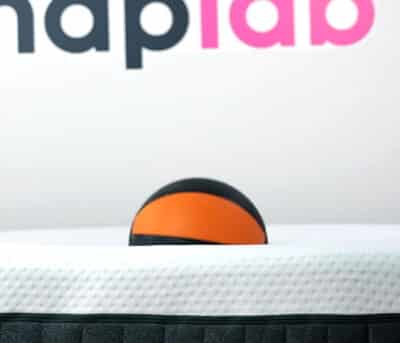
Max Bounce Height

The level of bounce is also documented in the video below.
As with so many other testing areas on the Emma Hybrid Comfort, the performance is being driven through the slightly firm feel and limited comfort layer.
These factors allow body weight to more easily make contact with the coil base, which creates a higher level of bounce rebound. The higher level of bounce is a boon for sex performance, however, as we discussed earlier, a detriment to motion transfer.
Edge Support Test
The Emma Hybrid Comfort has outstanding sitting edge support and excellent lying edge support. In our tests, we measured a sitting edge compression of 3.00”. This is 1.03” less sitting sinkage than the average of 4.03”.
Max. Sinkage
3.00″
Lying Support
Excellent
Reinforced Edge
No
When it comes to sitting sinkage I want to see 4.0” of compression or less. Needless to say, Emma easily hit that mark, creating a robust and supportive edge for sitting. Lying edge support was nearly as good.
The level of edge support while seated is documented in the images below.
Sitting, 140 lbs.

Sitting, 200 lbs.

The level of edge support while lying is documented in the images below.
Lying on Edge, 140 lbs.

Lying on Edge, 200 lbs.

When lying directly on the edge of the mattress I felt well supported in all sleeping positions. The slightly firm feel and limited total sinkage depth ensure that strong support extends to the very edge of the mattress.
The only notable weak spot for edge support was at the mattress corners. The corners felt a little squishy compared to the perimeter edges.
Sex Test
The best mattresses for sex have high bounce, good edge support, quiet materials, and good pressure relief and cooling.
These 5 factors make up the NapLab sex performance score.
| Sex Factor | Factor Weight | Score | Rating |
|---|---|---|---|
| Bounce | 65% | 10 | Extremely High |
| Edge Support | 20% | 10 | Outstanding |
| Noise | 5% | 8.0 | Moderate |
| Pressure Relief | 5% | 7.0 | Fair |
| Cooling | 5% | 9.0 | Excellent |
The Emma Hybrid Comfort has excellent sex performance
The Emma has extremely high levels of bounce combined with excellent edge support. These two factors alone make up 80% of the sex score and are hugely influential factors in this category.
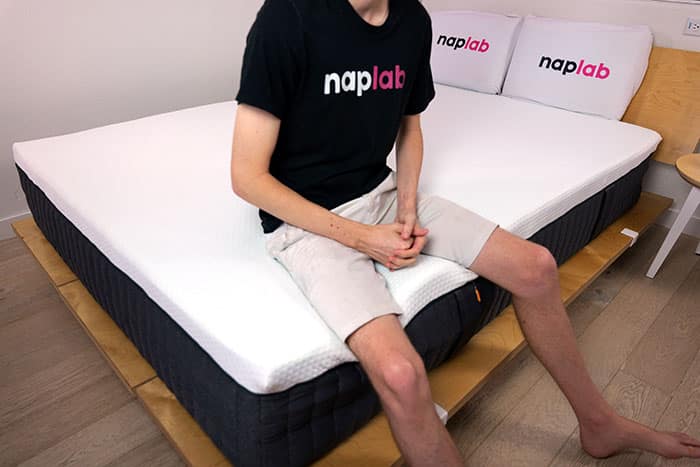
Generally speaking, most mattresses with a slightly firm feel and good bounce usually do really well for sex score.
In addition, the Emma has good enough pressure relief with excellent cooling. There’s a moderate level of noise, but nothing too disruptive—overall very good performance.
Pressure Relief Test
Pressure relief on the Emma Hybrid Comfort is fair. In our tests, I felt a slight to moderate level of pressure points building on my body.
Comfort Layer
1.75″
Support Layer
10.25″
When we consider the materials and design it’s easy to see why. We have just 1.75” of comfort material on top. This is significantly less than the average of 4.1” (based on all of our tests to date).
When it comes to pressure relief, mattresses with thicker comfort layers almost always create better pressure relief. In general, I want to see at least 3.0”, with 4.0” or more being ideal.

At 1.75” Emma is well short of what I view as optimal. This mattress really feels like one that’s designed more for the needs for stomach and back sleepers who need and prefer the slightly firm feel.
The limited sinkage and restrained body contouring can work well for those types of sleepers. However, the pressure relief dynamic, lack of sinkage, and slightly firm feel makes this mattress less than great for most side sleepers.
Off-Gassing Test
Off-gassing on the Emma Hybrid Comfort is good.
The smell was strong right out of the box. It took 7 days to fully off-gas which matches the average days we see in our testing..
Initial Smell Strength
Strong
Off-Gassing Period
7 days
While the length of off-gassing was similar to average, I will say that by the end of day 2, the odor was notably reduced.

If you’re sensitive to strong odors, this score may be an issue, but all things considered, off-gassing is a “one-and-done” process and not something that will affect the mattress’s performance long-term.
Company
The company score takes a look at factors that may influence your experience with the mattress.
Factors include length of the trial period, warranty, shipping / return costs, and country of origin.
| Company Factor | Factor Weight | Score | Data |
|---|---|---|---|
| Returns | 40% | 10 | $0 |
| Trial Period | 30% | 8.0 | 100 nights |
| Warranty | 20% | 8.0 | 10 years |
| Shipping | 10% | 10 | $0 |
| Country of Origin | 0% | Global |
Emma has decent company policies.
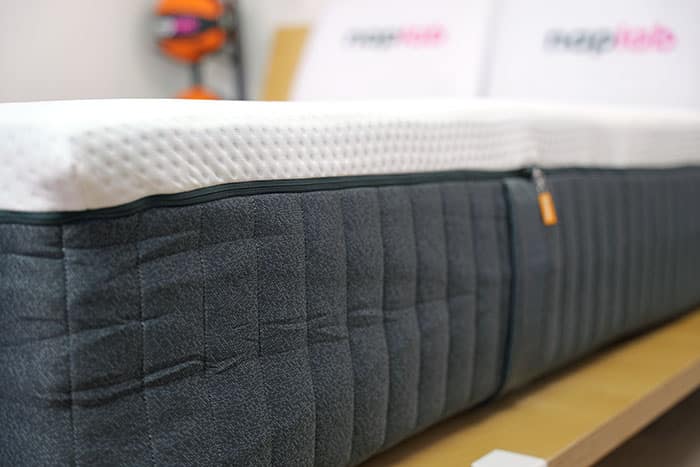
Emma has a 100-night trial period and a 10-year warranty. Shipping and returns are both free, which does help provide some peace of mind when trying out the Emma.
Comparing all mattresses tested to date, this trial is shorter than average (173 nights) but the warranty is 3 years shorter. (average is 13 years).
How firm is the Emma Hybrid Comfort?
The Emma Hybrid Comfort is available in one firmness – 7 out of 10 where 10 is the most firm.
This gives the mattress a slightly firm feel, and although it’s firmer than average, it would still be suitable for a wide range of sleepers.

The Emma has a minimal level of sinkage and restrained hug and contour. It would be an ideal choice for stomach or back sleepers, but not so great for side sleepers.
Support & Sleeping Positions
Support on the Emma Hybrid Comfort is excellent, provided the slightly firm feel, pressure relief dynamic, and limited sinkage level work well for your body.
| Support Factor | Data |
|---|---|
| Comfort Layer | 1.75″ |
| Support Layer | 10.25″ |
| Firmness | Slightly Firm |
| Body Contour | Slight |
| Zoned Support | Yes |
| Reinforced Edge | No |
While I did feel well supported by the mattress during our tests, the pressure relief issues can create pressure that feels sub-optimal for many sleepers (as it did for me).
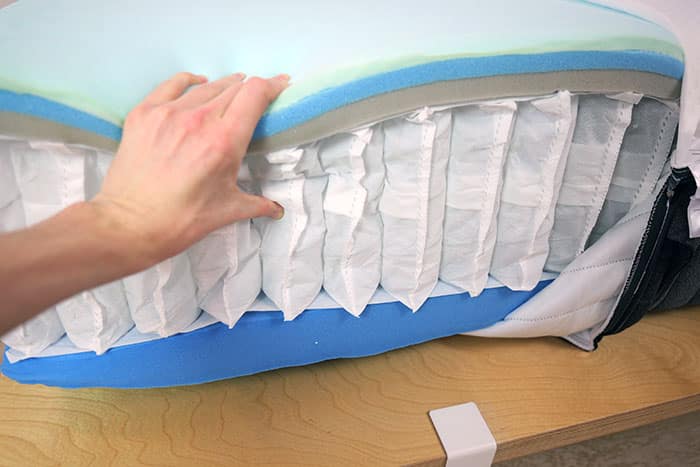
The incredibly limited 1.75” comfort layer may be sufficient for the needs for stomach and back sleepers, but it doesn’t do much for side sleepers.
Based on all of our tests to date, we have seen an average comfort layer thickness of 4.1”. The thicker foam creates better pressure relief. In addition, it’s better able to meet the support needs for side sleepers.

For these reasons, I would advise caution for most side sleepers on this mattress. It is best for stomach and back sleepers and anyone else who likes a slightly firmer feel with a restrained level of body contouring hug
| Sleeper Weight | Stomach Sleepers | Side Sleepers | Back Sleepers |
|---|---|---|---|
| Under 150 lbs. | Yes | No | Yes |
| 150-250 lbs. | Yes | No | Yes |
| 250-300 lbs. | Yes | Maybe | Yes |
Design
The Emma Hybrid Comfort is a 12″ hybrid mattress with a zoned support system (7 distinct zones) and a slightly firm feel. It has minimal sinkage and restricted contour.
| Design Factor | Data |
|---|---|
| Type | Hybrid |
| Thickness | 12″ |
| Cover Type | Thin |
| Weight | 55 lbs. |
| Has Handles | Yes |
| Fiberglass-Free | Yes |
| Ships in a Box | Yes |

Materials
The Emma Hybrid Comfort mattress has an overall thickness of 12″ and contains a mix of foam and coils. From top to bottom, the layers include:
| Layer Type | Thickness | Layer Specs |
|---|---|---|
| Poly Foam | 0.5″ | Not Available |
| Memory Foam | 0.5″ | Not Available |
| Poly Foam | 0.75″ | Not Available |
| Pocketed Coils | 7.75″ | Not Available |
| Support Foam | 2.5″ | Not Available |
As a note, the website says the mattress is 13″ thick, but as you can see, the mattress we tested came in an inch shy of this thickness—only 12″.
Here is an inside look at the Emma Hybrid Comfort.

The top 3 layers (1.75″) are part of the comfort layer and the bottom 10.25″ is reserved for support material.
The Cover
The cover of the Emma Hybrid Comfort is thin, soft, and has a decent amount of stretch to it. It is designed to wick away moisture and limit heat retention.
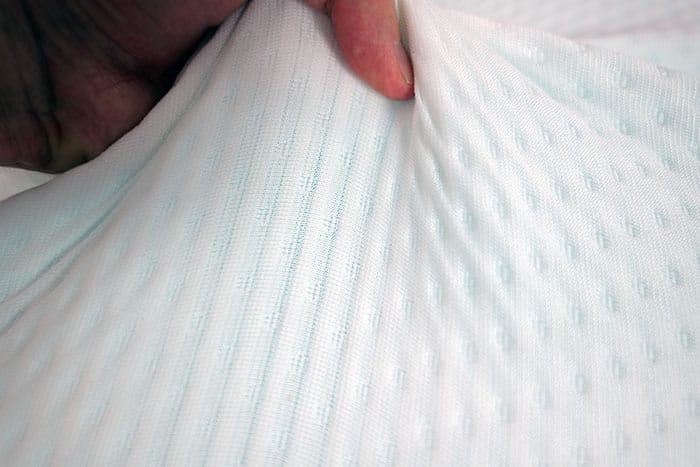
Considering the excellent cooling performance in our tests, the cover seems to be doing its job—no complaints here.
The Comfort Layer
The comfort layer contains three different layers of foam. The top layer (green) is a 0.5″ poly foam directly followed by a 0.5″ memory foam layer (blue). The third layer is a 0.75″ layer of poly foam (gray).

Overall, these layers are all extremely thin compared to the comfort layers on other hybrids we’ve tested. The average comfort layer is 4.16″ thick, but on the Emma Hybrid Comfort we’re only seeing 1.75″.
Even if these were the highest quality foams on the market, there is just not enough material to successfully support all sleeper types.
The Support Layer
The support layer contains two layers—a 7.75″ of support coils and a 2.5″ layer of high-density support foam. Considering the total thickness of the mattress, over 85% of the material thickness is devoted to support.
Support Coils

Support Foam

Ideally, I like to see at least 30% designed for comfort and up to 70% designed for support. Much beyond this threshold, the mattress performance starts to suffer, which is what happened here with the Emma Hybrid Comfort.
Product Evolution
Emma, as a company, has undergone significant levels of product evolution.
Looking back in the Emma vault, we see many mattresses that led to the launch of the Emma Hybrid Comfort.
- The Emma ComfortAdapt Hybrid was first launched in 2017 in the UK and then released in the US market in 2019.
- In July 2022, the name was changed from the Emma ComfortAdapt Hybrid to the Emma Original Hybrid.
- In late 2022, the Original Hybrid was replaced by the Emma CliMax, a hybrid designed with improved cooling performance over previous models.
- In September 2023, the Emma CliMax was discontinued and replaced by the Emma Hybrid Comfort (US link here & Canada link here).
With each of these name changes we also saw design and material changes. The mattress has gradually increased in thickness. However, it has always remained a hybrid with a slightly firm feel over the years.
Other Mattresses to Consider
Not sure if the Emma Hybrid Comfort is the right pick for you? Check out these three other top-rated Canadian hybrids you may want to consider.
For Motion Transfer

Silk & Snow Hybrid
Memory Foam Feel
The Silk & Snow Hybrid is a 12″ thick hybrid mattress with a memory foam feel, balanced by fast material response time and good edge support. Compared to the Emma, this mattress has 36% less motion transfer and also better pressure relief. The mattress has more sinkage around the midsection which can be advantageous for side sleepers as well.
For Side Sleepers

Emma Original
Softer Emma
The Emma Original mattress is an all-foam mattress with a thickness of 12″. This mattress has a softer feel (5 out of 10) compared to the Hybrid Comfort (7 out of 10). If you’re looking for a softer feel, deeper contour, or just something suitable for side sleepers, the Emma Original is likely the better choice.
For Budget
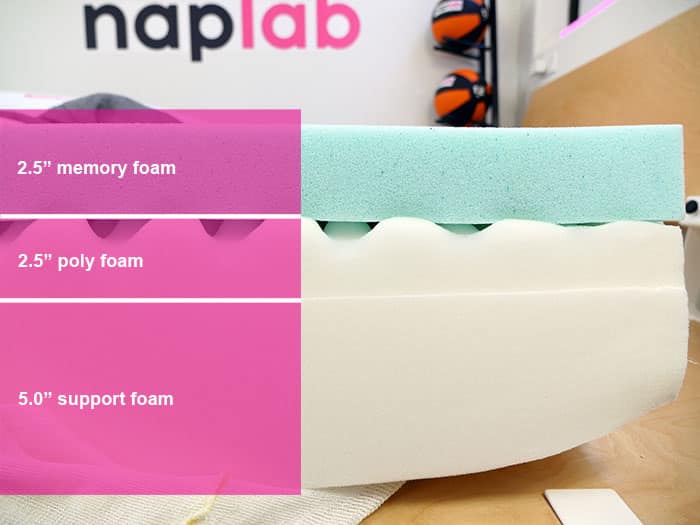
Siena
10″ All-Foam
The Siena mattress is a 10″ all-foam mattress with a 2.5″ top layer of memory foam and therefore has a different feel than the Emma. Siena is not a hybrid so it has lower levels of bounce and much deeper levels of sinkage. If you’re on a very tight budget, this could still be an option, though it lacks some of the advantages of the Emma (namely cooling, edge support, and sex performance).
Frequently Asked Questions
Still have questions? Check out some of the top FAQs on the Emma Hybrid Comfort mattress below and get the answers you’re looking for.
Here are the current prices, with any sales or promotions reflected below:
Twin: $369
Twin XL: $499
Full: $519
Queen: $599
King: $749
Cal. King: $749
*Note: Sales prices are subject to change without notice or warning.
Emma mattresses are made in the UK and Ireland with its headquarters located in Frankfurt, Germany. Despite Emma’s deep international roots, orders placed from within the US will be shipped from a US-based warehouse.
Emma offers shipping within the contiguous United States, excluding the following:
• Alaska
• Hawaii
• Puerto Rico
• US Virgin Islands
• American Samoa
Shipping takes between 2-5 business day to arrive at your door from the day it is shipped.



